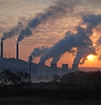AMHERST, MA - Researchers at the Political Economy Research Institute (PERI) at the University of Massachusetts Amherst today published new editions of the Greenhouse 100 Index, ranking U.S. companies by their emissions responsible for global climate change according to the U.S. EPA Greenhouse Gas Reporting Program, and the Toxic 100 Air and Toxic 100 Water Indexes, ranking U.S. industrial polluters using the U.S. EPA Toxics Release Inventory. The PERI Indexes include Environmental Justice indicators to assess impacts on low-income people and minorities.
The Greenhouse 100 Index ranks companies by 2017 direct emissions from large sources. The top three companies, Vistra Energy, Southern Company, and Duke Energy, each released almost 100 million metric tons or more of CO2-equivalent emissions in 2017. Together these three released more than 5 percent of all (energy, industrial, agricultural, transportation, and household) U.S. greenhouse gas emissions.
Rounding out the top ten in the Greenhouse 100 are Berkshire Hathaway, American Electric Power, NRG Energy, Xcel Energy, FirstEnergy, and Calpine, with the U.S. government ranking 7th. The top company whose direct emissions are not dominated by electric power plants is Exxon Mobil at rank 11. Among the top ten, Calpine has the highest weighted share of minorities living within 10 miles of its facilities with likely disproportionate exposure to co-pollutants of combustion.
The Toxic 100 Air Polluters Index reports that the top ten 2017 companies in terms of total potential chronic human health risk are Huntsman, Boeing, LyondellBasell, DowDuPont, Celanese, Mitsui, BASF, Arconic, Eastman Chemical, and Royal Dutch Shell. The new list differs from the previous Toxic 100 Air list in part because EPA has increased its toxicity assessment of ethylene oxide, increasing the estimated risk from companies releasing this chemical. The Toxic 100 Air Index covers publicly-traded as well as privately-held companies, such as Koch Industries at rank 17, that appear on Forbes, Fortune, or S&P lists.
The Toxic 100 Air Polluters Index includes environmental justice indicators showing companies’ pollution burden on minority and low-income communities. While minorities make up just under 40 percent of the U.S. population, minorities bear, for example, 67 percent of the air-toxics risk from facilities owned by LyondellBasell.
The Toxic 100 Water Polluters Index ranks the pounds of toxics released into surface water or from water-treatment systems, adjusted for chemical toxicity. DowDuPont, Northrop Grumman, and Parker-Hannifin top the Toxic 100 Water index for 2017.
In addition to the top-100 lists, a search facility provides information on all companies reporting releases to the Toxics Release Inventory or the Greenhouse Gas Reporting Program.
“The Toxic 100 and Greenhouse 100 inform consumers, shareholders, regulators, lawmakers, and communities which large corporations release toxic and climate-altering pollutants into our environment,” said Professor James Boyce, co-director of PERI's Corporate Toxics Information Project. “We assess not just how many pounds of pollutants are released, but which are the most toxic. People have a right to know about toxic hazards to which they are exposed. Legislators need to understand the effects of pollution on their constituents.”
“In making this information available, we are building on the achievements of the right-to-know movement,” explains Professor Michael Ash, co-director of PERI’s Corporate Toxics Information Project. “Our goal is to engender public participation in environmental decision-making, and to help residents translate the right to know into the right to clean air, clean water, and a livable planet.”
Contact: Kim Weinstein, 703/229-2146,
For further information, visit PERI's Corporate Toxics Information Project at toxic100.org.



